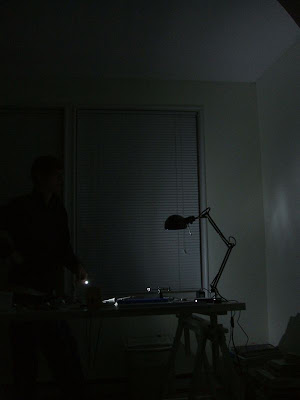It's the same idea as before, only the white LEDs are shaped differently because they have their own heatsink that they are mounted on. The two bullet lights are going to be smaller side lamps, while a large bullet headlight is going to be the main headlight.
I am reposting the circuit diagram here for reference:

So to begin with, I gave the white LEDs a test to check their brightness. Here's a photo of the test:

I soldered wires to the LEDs:

Then I mounted the LEDs in the white bullet lights:

I also used the larger white bullet light which is to be the main headlight:

Here it is opened up. I removed the light bulb but did not bother removing the battery case, as it was riveted in place and would have been very difficult to remove without damaging anything:

Then all that remained was to mount the lights. I mounted the headlight on the front derailler bar:

Here's a good photo of the white LED in the front lamp:

I mounted the rear bullet lights using some of the premade mounting holes on the trike frame. Also visible are the wire crimps I used to connect up the whole trike. I am going to put black heat-shrink tubing over the crimps so they're not quite so visible:

The large rear lamp was mounted to the rear fender. I drilled a 1/4" hole, and the light included all the mounting hardware:

Here is a couple of photos of all the tail lights together:


And finally, a view of the front bullet lights. The fender mounts had these cool little mount points that ended up being perfect for the lights:

Finally, all the wires (made of black 20 gauge lamp wire held in place by black zip ties) were run to a bag strapped behind the seat. The bag is just the right size to hold the electronics box:

And there you go! The lights are bright as heck! I calculated the batteries as lasting around 2.5 hours, but we haven't tested the system to that limit yet, as we generally recharge the batteries after every ride anyway.

2 comments:
Just curious - I can see no reason for the bridge rectifier in your circuit apart from allowing the unit to work even if the battery is connected backward....
The bridge rectifier is so that a bike generator can be used for power at some point. Since generators make alternating current, a rectifier is needed. Capacitors would be nice with a generator to smooth out the pulses of power, but in practice the pulses aren't really all that noticable.
Post a Comment